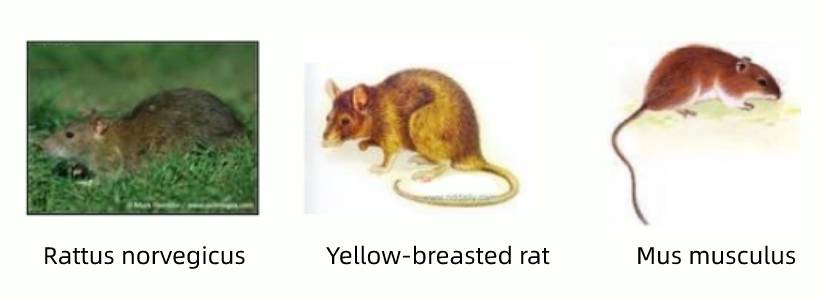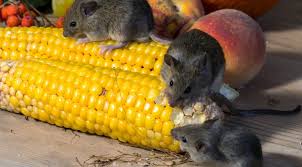Date: 30,03,2023
Author: Aosion
.jpg)
Rats are rodents that come in different sizes. There are many kinds, more than 450 kinds. There are tens of billions of them in the world. The reproduction speed is very fast, the vitality is very strong, it can eat almost anything, and it can live in any place. They can dig holes, climb trees, climb mountains, and wade in water. They also waste food and spread diseases, which are extremely harmful to humans. Rats have very mixed eating habits, and they like to eat a lot of things. They eat almost everything that people eat. They are not afraid of sour, sweet, bitter and spicy. But their favorite food is grain, melon seeds, peanuts and oil-pressed food. A mouse can eat about 9kg of food a year. In addition to consuming or contaminating food, rats like to grind their teeth, so the damage to packaging materials or construction equipment due to rat bites is quite considerable. According to statistics, one quarter of the fires in the United States with unknown causes may be caused by rats biting wires cause. Mice are very easy to adapt to the living environment of human beings, so they become the main harmful animals. Rats often haunt sewers, toilets, kitchens, etc., move back and forth between bacteria-carrying places and clean places, and spread pathogenic bacteria through rat feet, body hair and stomach contents. Currently common in China are Rattus norvegicus, yellow-breasted rat and Mus musculus.

Distributed all over the country, the rat exists wherever people live. It is the most important rat pest in the vast rural areas and towns. It has a large number and great damage. It is a larger type of house rat, with a body length of 150-250 mm and a weight of 220-280 grams. The tail is obviously shorter than the body length. Widely used as domestic and wild amphibious rat species. Indoors, it mainly camps in hidden places such as corners, walls, kitchens, warehouses, underground passages, and garbage dumps. Outdoors, they live in caves in firewood stacks, rock piles, walls, and gutters. Rattus norvegicus has strong fecundity and can produce 6-8 litters a year. The pregnancy period is about 3 weeks, with 7 to 10 litters per litter, up to 15 litters. Pups reach sexual maturity about 3 months after birth and live for about 2 years. Rattus norvegicus has a wide and mixed diet, and it can eat any food that humans use. He likes to eat meat products and apples and other fruits with high water content, and he likes to eat wheat, rice, etc. among grain foods.
Medium-sized, slender than Rattus norvegicus, with a body length of 135-210 mm; the back hair is brown or yellowish brown, and the color of the middle of the back is darker than that of the side of the body. Head brownish black, slightly darker than body hair. The belly is greyish-yellow, and the chest is more yellowish. The yellow-breasted rat is one of the main domestic rat species in my country. It is agile and has a strong climbing ability. The upper floors of buildings, roofs, tiles, wall crevices and ceilings are often places for them to hide and move. At night, yellow-breasted mice will go down to the ground to feed and find water sources. In places where the density of yellow-breasted mice is high, traces of them crawling up and down can be seen on buildings. Mostly active at night, most active at dusk and early morning. Yellow-breasted rats have a mixed diet. They like to eat plants and foods with more water. They eat human food and small animals. Some eat melon crop receptacles and pulp. They mainly live indoors. mouse. It also bites bad clothing, furniture and utensils, bites bad wires, and even causes fires. There is obvious mutual repulsion with Mus musculus, the struggle between the two is very fierce, often the winner lives, the loser is repelled, and the number is very small.
It is widely distributed and spreads all over the country. It is a dominant rat species second only to Rattus norvegicus in the number of domestic rats. The population is large and destructive. It is a small mouse in the family Muridae, with a body length of 60-90 mm, a weight of 7-20 grams, and a tail equal to or slightly shorter than the body length. Mus musculus is a companion species of human beings, and its habitat is very wide. Wherever people live, there are traces of Mus musculus. Houses, kitchens, warehouses and other buildings, suitcases, kitchen cabinets, etc. are the habitats of Mus musculus. It likes to eat all kinds of grains and oil seeds. It hides at night and scurries around. It is very destructive to plastic bags, small packages and cartons. Mus musculus is active day and night, but it is mainly nocturnal, especially in the morning and evening, forming two obvious activity peaks. The mouse has strong fecundity and can reproduce all year round. The reproductive rate is higher in spring and autumn, and lower in winter. The gestation period is about 20 days, and it can give birth to 6 to 8 litters a year, with 4 to 7 litters per litter. Newborn rats can reach sexual maturity and participate in reproduction in the same year. It is very harmful in residential areas and penetrates everywhere. It often bites clothes, food, furniture, books, and other household items can be damaged and polluted by it. At the same time, a large number of people come and go in and out of human residences, which can spread certain natural foci of diseases.

Mice are the storage hosts or vectors of many diseases. It is known that 57 diseases transmitted by mice to humans include plague, epidemic hemorrhagic fever, leptospira, typhus, and tick relapsing fever. Rodents can transmit diseases directly to humans or through ectoparasites to humans and animals. According to expert estimates, the number of lives claimed by rodent-borne diseases in history exceeds the sum of the deaths of all wars in history. The Beijing area of China is also in the epidemic area of epidemic hemorrhagic fever. In 1997, 22 cases of epidemic hemorrhagic fever occurred in Beijing, China, and in May 1998, 24 cases of epidemic hemorrhagic fever occurred. In May 1999, the incidence of epidemic hemorrhagic fever exceeded The sum of the whole year in 1998 shows that the scientific inference that every 10 years is the peak period of rat-borne diseases is quite correct.
Three ways to spread disease:
(1). Rat ectoparasites are used as a medium to transmit the pathogen to humans when they bite the human body and suck blood;
(2). Rats with pathogenic microorganisms in their bodies pollute food or water sources through rat activities or feces, causing human illness after eating;
(3). Rats bite directly or the pathogen invades through trauma to cause infection.
The biting habit of mice directly endangers cables, and optical cables cause equipment disconnection or damage. 20% of the fires in the world are caused by mice.
1. Rodents reproduce very fast. Each female rat breeds an average of 44.5 young rats each year to join the population. A pair of adult rats will have 15,000 offspring after one year. It can be said that ten generations live together. As the saying goes, "one male plus one female , two hundred and five years in three years". Spring and autumn are the peak seasons for mouse reproduction. If the food and hiding conditions are suitable, the population can reproduce in all seasons.
2. Rats are greedy animals. Due to their high activity and fast growth, their food intake is also very large. The food that rats eat every day is equivalent to one-tenth to one-fifth of their own body weight. More. A rough estimate of the ratio of the three is to eat one portion, waste two portions, and dirty four portions, and the harm of eating and moving is even greater.
⒊ Although mice are color-blind and can't distinguish colors, they can detect moving objects in a very dark environment and distinguish objects of different sizes and shapes. The farthest distance can reach 15 meters, but the object is gray, so bright yellow or bright green is used as poison bait to reduce bird feeding.
4. Mice have very keen sense of hearing. They are not only sensitive to sudden small sounds, they can also hear ultrasonic waves with vibrations below 15,000 times per second, and send out ultrasonic waves to communicate with each other, while humans and cats are unaware of it.
⒌ The senses of smell and taste of mice are also relatively developed. It is used to determine the location of food and identify the function of smell. Its sense of touch is quite alert. The beard and bristles around the body enable them to move freely along walls and holes in the dark.
6. Rats are good at climbing and can jump from a height of 15 meters without any damage. Rats are good swimmers and can dive for 30-80 seconds and float in water for 70 hours. Rats are good at digging holes, and they can make nests in corners, bushes, and debris piles that can be used as hiding places. Generally, there are 2-4 holes, and a large amount of food is stored in the holes. Rats can survive in food refrigerators at minus 24 degrees Celsius. Breeding, can also live in conditions of 40 degrees above zero.
⒎ The teeth of a mouse can grow up to 13 centimeters in its lifetime, so it needs to gnaw on hard objects constantly, especially when it is not hungry, it needs to gnaw on relatively hard furniture, doors, windows, and walls. Its bite is developed, its chewing force can reach 260 kilograms per centimeter, the frequency is 90 times per minute, and its destructive power is quite large.
8. The dominant populations in Beijing area of China are Mus musculus and Rattus norvegicus. Mus musculus can drill through a 6 mm hole, and Rattus norvegicus can drill through any hole larger than 1.25 cm. Climb over horizontal or vertical cables and walk horizontally on any form of tube. 3. Rodents cause huge losses to agriculture, animal husbandry and industry
The world's food loss due to rodent infestation can reach 15%-20% of the harvest, which is equivalent to the gross national income of 25 poor countries and enough for 150 million people's annual rations. In my country, nearly ten million mu of forest and one billion mu of grassland are destroyed into deserts or barren islands every year, and the loss exceeds 3 billion yuan. The losses caused by urban industrial rodents are very serious. Rats bite the cable insulation material to cause short circuit, drill into the transformer to cause explosion, and cause high-voltage lines to cause strong magnetic field induction to breakdown and burn down equipment. Many fires caused by unknown causes in the city are related to the fire caused by the damage of the circuit caused by rat bites. As for biting all kinds of items in the residents' homes, there are countless more.

There are many Mus musculus in homes, offices, and office buildings, and the effect of using sticky mouse boards is safe and reliable (some countries and regions restrict the use of sticky mouse boards, please use them legally according to local regulations). The sticky mouse board should be placed along the "rat path", placed on the back side of the door and the bottom of the cabinet, and it will be effective if it is kept for 3-5 days. If necessary, install rodent pest repellent, electronic mouse killers, or put mouse traps, and then block some major intrusion channels with mouse-proof foam fillers to complete the task of rodent control! Traditional mouse traps and mouse cages use deep-fried dough sticks and peanut kernels as bait to enhance the effect of luring the bottom. All sewer inlets and outlets should be covered with barbed wire mesh with a mesh size of less than 1 × 1 cm to prevent rats from escaping. The doors of kitchens, restaurants, warehouses, deli rooms, and snack rooms must be nailed with galvanized iron sheets 30 cm high to prevent mice from biting. Usually do not litter the windows or green belts to reduce the habitat of mice.

⑴ 2 pieces of powder for every 15 square meters of room (20x20 cm along the wall, about 2 pennies thick fossil powder), the positive powder after one night does not exceed 3%; the room with rat holes, rat droppings, and rat bites does not exceed 2%; No more than 5% of rodent-proof facilities in key units are unqualified.
⑵ There are no more than 5 rat trails within 2,000 meters of different types of external environments.
⑴ Before extermination of rodents, it is necessary to cut off rat food in time, thoroughly remove garbage, control non-compliant storage of grain and food, especially leftovers from the catering industry, which need to be sealed and kept, and kitchen waste should be sealed and transported in time.
⑵ The abandoned food and accumulated water in the external environment that can be eaten by rats should be cleaned up in time.
1. The doors and windows are tightly closed. The gap between the door and the door frame, the window and the window edge should be less than 6mm. 30 cm high iron sheets inside and outside the package; 13x13 mm barbed wire should be installed on the windows and ventilation holes in the basement or the first floor of the building.
2. The holes where various pipes or cables enter and leave the building are blocked with cement and other materials; the indoor holes and gaps that may be used by rodents are also filled with cement.
⒊ The sewer should be equipped with a return water bowl, the indoor drain should be equipped with a complete iron grate, and the part leading to the outside water outlet should have a 13x13 mm rodent-proof wire gate.
4. Wooden doors of warehouses for grain, non-staple food, condiments, medicines, etc. should be covered with 30 cm high iron sheets, and doors that are often opened should be equipped with 50 cm high iron sheet anti-rodent baffles. rat board.
You might be also interested in the following articles:
Subscribe to our newsletter to be kept abreast of our latest news, events and great deals.